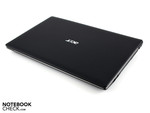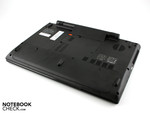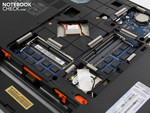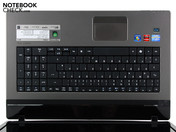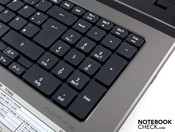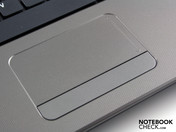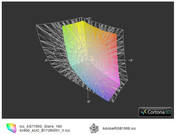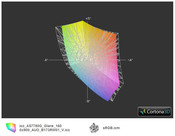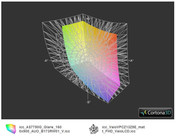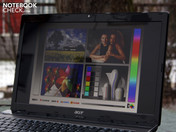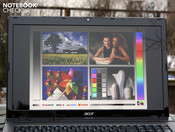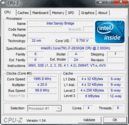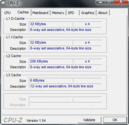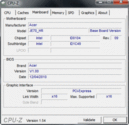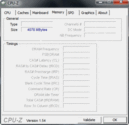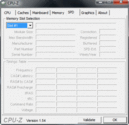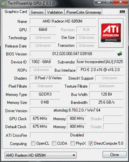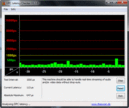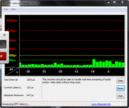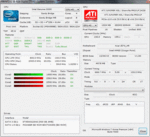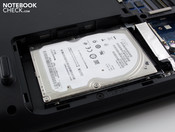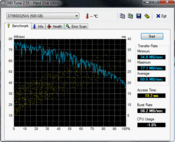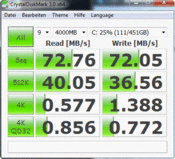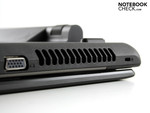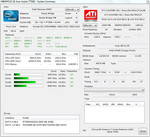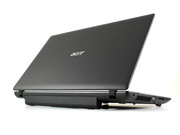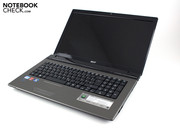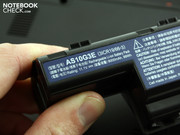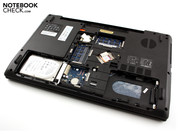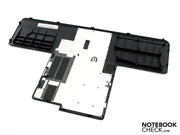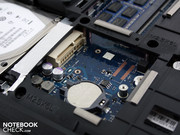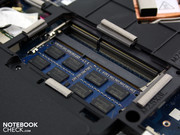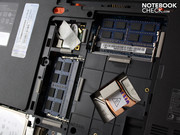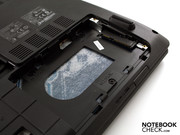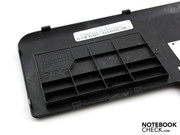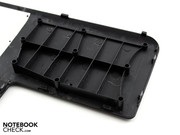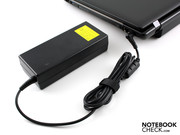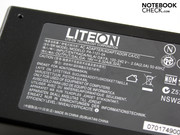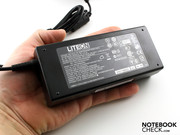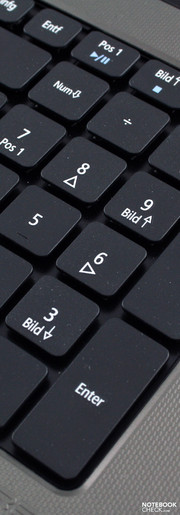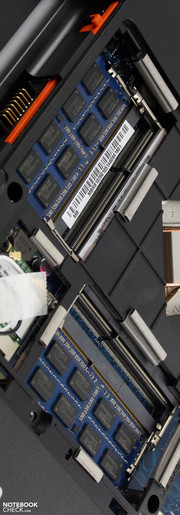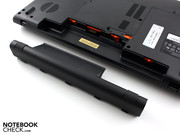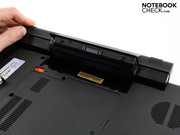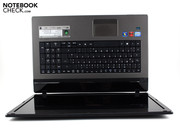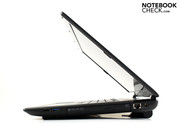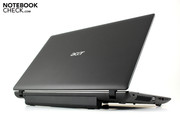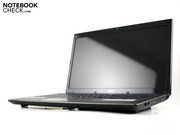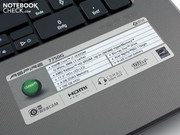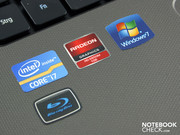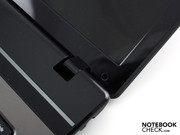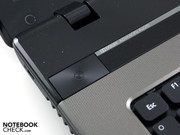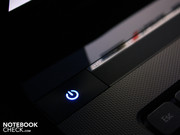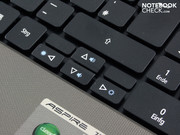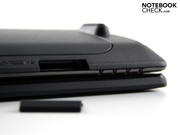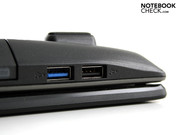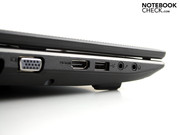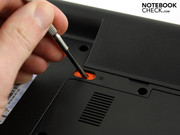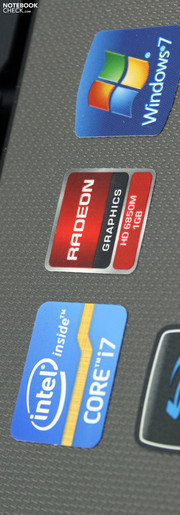Review Acer Aspire 7750G Notebook

To test or not to test, that is the question. Our present test device, Acer Aspire 7750G-2634G50Bnkk, is based on a Cougar Point chipset from the "Sandy Bridge" generation. As it has now been discovered and Intel also has admitted, it has faulty 3GBit/SATA/s-ports (that could possibly turn up sooner or later). See: Intel's defective Sandy Bridge Chipsets – status report.
We opted for the test because the deterioration on the clock generator, which is the source of the Sandy Bridge defect, can't turn up on a brand new device. If at all, according to the latest information, a performance decrease or even deficient 3GBit/SATA ports will first turn up after months.
Short: The Acer Aspire 7750G with a Cougar Point chipset, like it's on our desk today, will have the same performance as an updated 7750G in April 2011. The revamped Intel chips are to be available for retail in the according PCs at the earliest at this point.
So, we will occupy ourselves with an interesting combination of Core i7-2630QM (4x 2.00GHz), AMD Radeon HD 6850M and BluRay drive (read only). Will the 17 incher for almost 1000 euros present strong multimedia competence? How will the HD 6850M measure up to its predecessor HD 5850? Also, find out how a system with a 45 watt CPU can provide mobility of 5 hours anyway.
Case
The 7750G can sooner be described as a plain laptop. The 17 incher would pass as an unstriking office machine if it weren't for the strong hardware. The fairly slim case is adorned by a pressed-in haptical pattern on the work surface and lid. This provides a pleasant grip and for absolutely resists fingerprints and scratching ring fingers.
The fairly thin case is adequately stable, even if not perfect. We don't like the yielding area above and beneath the BluRay drive. We can nevertheless twist the case when held in both hands. The wrist-rest can be depressed with a bit of pressure on the right, where the configuration sticker is.
Flexibility continues in the lid. We can twist it by a few degrees. But then it doesn't budge any further. Pressure on the lid already provokes a clear yielding and pressure marks on the front.
Although the hinges keep the lid in position, they teeter evidently. We can't call them tightly pulled. Quite contrarily, we fear that the lid won't constantly be held in position after a while of intensive use. The maximum opening angle is wide: 140 degrees.
Connectivity
Interfaces don't belong to one of the 7750G's strengths. The three USB ports suffice for printer, mouse or external hard disk. However, one of them (right) supports USB 3.0 (Renesas Electronics). eSATA or ExpressCard34/54 aren't installed. Righties and lefties could equally be on a collision course with the USB, as well as HDMI or VGA cables, when using a mouse. Ports in the rear positions would have deterred cable chaos on the desk. But this way, the USB port location is only practical for plugging in memory sticks. Anything else would clutter the desk with cables.
Communication
The fastest WLAN draft-n standard supports the 802.11 b/g/n wireless card from Atheros (AR5B97). It also includes an incorporated Bluetooth module (3.0 +HS). The Atheros AR8151 PCI-E Gigabit Ethernet controller fits perfectly to the home gigabit switch. Thus, the 7750G is up to date in terms of network technology.
Upgrading
A few words about the upgrade option are due. We locate a total of four RAM bays for DDR3 modules underneath the large cover on the bottom. Theoretically, the i7-2630QM's memory controller can however only address up to 8 GB. DDR3-1066/1333. This gives the user the possibility of retrofitting the mentioned 8 GB with two inexpensive 2 GB modules for little money.
Supplies
No DVDs are included merely a manual and warranty card. The buyer has to create the recovery DVD for backing up Windows Home Premium 64 bit himself. Acer's eRecovery Management leads you through this. A vast amount of tools and programs are on the hard disk, partly as test versions, like Office Home and Student 2010, NTI Maker and McAfee Internet Security.
Acer clear.fi is a kind of management center for digital contents. Media files are made accessible in a common system with a standardized user desktop. Thus, every video or picture can be looked at from any device. No matter if smartphone, desktop or laptop, if they are logged into the Windows network, they share information. Acer uses this concept of a Windows home network and puts a pretty surface in Media Center style over it. So, the user will (hopefully) only have to think about drives, shares and passwords once.
Warranty
Acer grants a 24 month bring in warranty for this product. Thus, users have to send in their broken laptop themselves.
Input Devices
Keyboard
The keys provide the user with a clear pressure point, but only a soft keystroke. This is due to the overall pliable key surface, which already yields clearly under slight pressure. Together with the short key drop, an unsatisfying typing feel develops that no ambitioned office worker will want to live with permanently.
The installed number pad is an aid for inputting rows of numbers. It's also pleasant that it is a full-fledged number pad without minimized or omitted keys. The arrow keys are only half the size of standard number keys since they aren't allowed to protrude into the wrist-rest. A small gap at least provides for good palpation.
Touchpad
The mouse replacement is a Synaptics multi-touch pad (v7.5). As usual, it's capable of multi-finger gestures, such as zoom. The little pad's smooth surface can be used quickly and is sensitive up to its edges. Two finger gestures are implemented accurately and without delay. The keys click rather quietly and have a medium key drop. The short pressure point unfortunately comes shortly before the stroke, which makes the key feedback overall average.
The pad has horizontal and vertical scroll bars, whereby the vertical bar has been marked haptically. The scroll field is no longer mandatory due to multi-finger gestures. Users can disable the scroll fields and thus enlarge the pad surface.
Display
The 17.3 inch display can just satisfy high demands with its viable brightness. Everything else belongs in the low budget sector. The screen (AUO B173RW01 v3) has a resolution of 1600x900 pixels (WXGA++, 16:9). If you need a lot of overview on your screen, you can happily live with this resolution.
The AUO screen has its weakness in a low contrast of 197:1. The glare type screen pretties up the weak contrasts optically, though. This results in a visually crisp color impression. The colors are fairly attractive for consuming pictures, movies or games. The AUO screen isn't suitable for image processing professionals because the color spectrum doesn't even cover sRGB(t).
| |||||||||||||||||||||||||
Brightness Distribution: 95 %
Center on Battery: 215 cd/m²
Contrast: 197:1 (Black: 1.09 cd/m²)
58.4% AdobeRGB 1998 (Argyll 3D)
84.3% sRGB (Argyll 3D)
56.4% Display P3 (Argyll 3D)
The brightness measurement on the 17.3 inch screen shows acceptable results. The average brightness is 216 cd/m2. Our Gossen Mavo monitor selectively measures up to 222 cd/m2. Consequently, the illumination is very even with 95 percent. Thus, no bright spots will be seen on a completely black screen. User rarely need a brightness beyond 150 cd/m2 indoors. Is the brightness bonus enough to work outdoors in daylight, despite the glare type?
If you set up the Aspire 7750G in the sun and want to play a game of Battlefield, you should look around for a shadowy place to avoid reflections. Our pictures were made in overcast conditions. Because the 17 incher doesn't reduce its brightness in battery mode, the result is quite feasible. However, reflections could be disturbing depending on light incidence.
We can deviate up to 50 degrees on the horizontal plane. The colors start to invert more or less intensely after that. The brightness remains constant beyond that and script can be read up to 70 degrees without problems.
The colors start to falsify much faster, starting at 10 degrees on the vertical plane. The image bleaches and the colors invert. We experience the strongest restrictions when looking up or down from the side. Should several people want to watch a movie or look at pictures, visual problems will be the order of the day. However, this is a common phenomenon found in 90 percent of our test laptops.
Performance
We meet the Sandy Bridge CPU, Core i7-2630QM, with 4x2.0 GHz (standard clock) only for the second time. The gaming notebook, Deviltech Fragbook DTX (Clevo P170HM) could attain a strong application performance with this brand new CPU. The quad core is overclocked up to 2.9 GHz when needed via Turbo Boost, like in the Arrandale predecessors. This doesn't seem to be an innovation, but Intel speaks of "Turbo 2.0". Has it been optimized?
Yes. The processor can now benefit better from a good cooling system than the case was in the Arrandale cores. Intel calls this "Dynamic Range @ Turbo Frequency Limits". Depending on the cooling, there is a kind of headroom over the fixed maximum clock rates. Turbo enters this room as long as specific temperature limits aren't exceeded. The performance consequently decreases when the temperatures increase – but only in this headroom. The fixed clock rates are practically "guaranteed".
The result: After a phase without load and with sufficient cooling, the Core i7-2630QM can quickly overclock very high. Applications with a short-term maximum load benefit from this. The CPU can be increased to 2.6 GHz (load of 4 cores), 2.8 GHz (2 cores) and 2.9 GHz (1 core) dynamically with sufficient cooling. Detailed information with pictures: Review Intel Sandy Bridge Quad Core Processors.
In addition, alike in the Clarksfield predecessors such as i7-740QM, there is Hyper Threading. It simulates virtual cores, from which multitasking benefits. Applications can thus calculate on up to eight threads. A high performance is supported by the six MB L3 cache. The typical quad core TDP of 45 watts belongs to the consumer top range of mobile processors.
The graphics chip called HD Graphics 3000 (650-1100MHz) in the processor is an advantage compared with the Clarksfield quad cores. However, it's not enabled in our test device. The AMD Radeon HD 6850M consequently can't be disabled.
The results of the CPU benchmark, WPrime, with the i7-2630QM are, as expected, above the comparable 720QM (483s) and 740QM models (427s). The rule in this multi-core CPU test is, the fewer seconds the better. The 2630QM calculates by a whole 25 percent faster with 318s than the 740QM.
The Cinebench R11.5 CPU test (multi, 64 bit) gets down to business with 5.0 points. That is considerably more than a 740QM (3.4; MSI GX660R). Merely a 2820QM (5.7) can score even more (mySN XMG P501).
Thus, extensive rendering and converting tasks are exactly right for the processor and power-users will be served well. The i7-2630QM practically manages simple tasks, like internet, social networking, office, audio playback & co., in passing in energy saving mode.
| PCMark 05 Standard | 9075 points | |
| PCMark Vantage Result | 7402 points | |
Help | ||
The subjective work speed is very fast. PCMark Vantage shows the system performance (CPU, graphics, RAM, hard disk) in a single number. The 7750G achieves 7402 points. That is a remarkable rate, which moves the 17 incher into the performance machine series of laptops that we have previously reviewed. It is on par with the gamer, mySN XMG7.c (920XM, GTX280M) or the workstation, HP Elitebook 8740w (820QM, FX 2800M). Now only a fast SSD, as in Alienware M17x R3 (GTX 460M, i7-2630QM), can speed up the system even more. The named Alienware M17x reaches 12700 in PCMark Vantage with a Samsung SSD.
| 3DMark 2001SE Standard | 38862 points | |
| 3DMark 03 Standard | 26993 points | |
| 3DMark 05 Standard | 16944 points | |
| 3DMark 06 Standard Score | 9336 points | |
| 3DMark Vantage P Result | 6344 points | |
| 3DMark 11 Performance | 1656 points | |
Help | ||
The Seagate hard disk (ST9500325AS) has a capacity of 500 GB (gross). HDTune and CrystalDisk Mark show below average data throughputs of 60.6, respectively 72 MB/s in sequential read, even for its slow 5400 rpm. The burst rate reveals the maximum throughput speed at which data waiting in the HDD cache can be readout. Both of these factors don't lead to a particularly strong HDD score of 3356 points in PCMark Vantage. The 7750G would experience a real boost with a SSD. For example, as in Alienware's M17x R3 (same i7-2630QM), which achieves proud 19975 points in the HDD score with Samsnug's 256 SSD.
AMD officially announced more than 15 new GPU models with the new name Radeon HD 6xxxM at the beginning of January. The installed Radeon HD 6850M already belongs to the high-end category. The GPU is still based on the DirectX 11 graphics, Mobility Radeon HD 5850 with its Broadway Pro core. The same now runs under the name Granville Pro/LP, or also ATI Juniper XGL, as HWiNFO reads out.
The clock rate of 675/800 MHz (core/memory) is in the AMD specification ranges from 575-675 MHz (core) and 800 MHz (memory). Alike the predecessor, HD 5850, the small 128bit memory bus could turn out to be a bottleneck with the 1024MB GDDR3 RAM in the test device. The 6850M also supports GDDR5, which is too expensive for mass production installation.
As typical pessimists, we thus see a renamed HD 5850 before us, which is also confirmed by almost all 3D benchmarks. 3DMark 2006 classic finishes with 9336 points (HD 5850 avg. 9714 points). 3DMark 11 made for DirectX 11 achieves 1656 performance points (HD 5850 no score available). Unigine Heaven 2.1 saves itself to 15 fps (HD 5850 avg. 15 fps). The comprehensive 3DMark Vantage achieves 6344 points (HD 5850 avg. 5788 points). In 3DMark Vantage's case, the Radeon GPU lags behind Nvidia's upper range, GTX 460M by 29%. What do the games say about that?
Crysis
The shooter from the end of 2007 isn't only a milestone in the field of demanding games for historical reasons. There is only a stuttering 11 fps in maximum details, that is in FullHD via an external TFT. The gamer needs a considerably more expensive GeForce GTX 470M SLI configuration, as in mySN XMG U700 ULTRA, for having fun in this constellation. A drop of bitterness for Radeon fans: The clearly superior GeForce GTX 460M, in the Sandy Bridge Asus G73SW-TZ083V (2630QM), doesn't surpass 13 fps even in synthetic benchmarks. The shooter runs smoothly on the 7750G in high details, which we however only measure as 1024x768. The game won't be playable in the native 1600x900 pixels (high).
| Crysis - GPU Benchmark | |||
| Resolution | Settings | Value | |
| 1920x1080 | Very High, 0xAA, 0xAF | 11 fps | |
| 1024x768 | High | 41.5 fps | |
Risen
The action adventure is well playable with the HD 6850M in high details with 36 fps (1280x720). We couldn't record the measurement for high in the database because 1366x768 couldn't be set. The frame rates cave in to 23 fps in maximum details (FullHD).
| Risen | |||
| Resolution | Settings | Value | |
| 1920x1080 | high/all on, 0xAA, 4xAF | 23.2 fps | |
| 1024x768 | all on/med, 2xAF | 47.3 fps | |
Battlefield: Bad Company 2
The first person shooter form Electronic Arts had already chummed up with the HD 5850 predecessor in prior tests. The game was playable with about 43 fps in high details and a resolution of 1280x768. We should have set 1366x768 for the data base, but this again wasn't possible. Our 7750G can't cope with maximum details in FullHD (19 fps). A GTX 460M with GDDR5 would be required for this (+60%). Then again, the GTX 460M and HD 6850M are only apart by 5 to 10 percent.
| Battlefield: Bad Company 2 | |||
| Resolution | Settings | Value | |
| 1920x1080 | high, HBAO on, 4xAA, 8xAF | 18.9 fps | |
| 1024x768 | low, HBAO off, 1xAA, 1xAF | 74.8 fps | |
StarCraft 2
The game is smoothly playable in high setting (1280x768) with 36.5 fps. However, the FullHD resolution in ultra details caves in to 21 fps. The HD 5850 is on par. But not so the Nvidia opponent, GTX 460M that still manages 33 fps in ultra (average of test systems).
| StarCraft 2 | |||
| Resolution | Settings | Value | |
| 1920x1080 | ultra | 20.6 fps | |
Mafia 2
The nineteen-twenties shooter can still be played fairly smoothly even on the external FHD with a few restrictions with 27 fps. If you want more, you once again have to look at the GTX 460M . It is 29% faster in maximum details and FHD (35 fps). The older HD 5850 was still 11% faster (30%).The HD 6850 finished high settings (not recorded due to 1280x768) with very good 46 fps.
| Mafia 2 | |||
| Resolution | Settings | Value | |
| 1920x1080 | high, 0xAA, 16xAF | 27.1 fps | |
| 1024x768 | medium, 0xAA, 8xAF | 56.1 fps | |
Gaming Verdict
The Radeon HD 6850M proves to be made alike the predecessor, HD 5850. The performance is good for a gaming notebook, but can't keep up with an according Geforce GTX 460M due to the slow GDDR3 video memory. High and highest details (FHD) are always problematic. The GTX 460M with a GDDR5 has a clear advantage here.
| low | med. | high | ultra | |
|---|---|---|---|---|
| Crysis - GPU Benchmark (2007) | 41.5 | 11 | ||
| Crysis - CPU Benchmark (2007) | 34.74 | 10 | ||
| Risen (2009) | 47.3 | 23.2 | ||
| Battlefield: Bad Company 2 (2010) | 74.8 | 18.9 | ||
| StarCraft 2 (2010) | 20.6 | |||
| Mafia 2 (2010) | 56.1 | 27.1 |
Emissions
System Noise
Acer's 17 incher does its best to deliver exemplary rates in terms of system noise. It's not like the 7750G doesn’t make any noise during games or demanding applications. However, the fan management behaves very restrained in idle (up to 32.4 dB(A)). You can't complain about 40 dB(A) under load, either. The cooling system turns up to 37.6 dB(A) in our test games and 3DMark 2006.
Very agreeable: The fan turns evenly and when the stress test ends, the fan turns down to 32.8 dB(A) again within 20 seconds. The active fan now and again turns itself off in balanced/energy savings mode (CPU idle: 400-798 MHz). The always present but quiet noise in idle however originates from the hard disk's base noise.
Noise level
| Idle |
| 31.8 / 31.8 / 32.4 dB(A) |
| HDD |
| 32 dB(A) |
| DVD |
| 39.1 / dB(A) |
| Load |
| 37.6 / 39.9 dB(A) |
 | ||
30 dB silent 40 dB(A) audible 50 dB(A) loud |
||
min: | ||
Temperature
The temperatures really get down to business, even if only under full load. We measure almost 44 degrees Celsius on the bottom in the fan's vicinity in the stress test of processor and graphics card. The average of the entire surface is only 35 degrees though. It gets quite warm for the fingers on the keys with up to 46 degrees on the top.
The temperatures of the stress test should however not be seen as a reference for normal use. If you watch YouTube videos and write emails, you can be delighted about only lukewarm temperatures. The aforementioned load temperatures aren't even reached in computer games. Stress test means, both CPU and GPU are loaded to 100% capacity (Furmark + Prime95, all cores). Inside, the CPU heats up to 90 degrees Celsius during the stress test (GPU max 79 degrees).
Everything's cool in idle. The top doesn't heat up over 28 degrees and the bottom doesn't come close to 30 degrees. The work surface's average temperature is only 25 degrees in idle.
(-) The maximum temperature on the upper side is 45.7 °C / 114 F, compared to the average of 36.9 °C / 98 F, ranging from 21.1 to 71 °C for the class Multimedia.
(±) The bottom heats up to a maximum of 43.9 °C / 111 F, compared to the average of 39.2 °C / 103 F
(+) In idle usage, the average temperature for the upper side is 24.9 °C / 77 F, compared to the device average of 31.3 °C / 88 F.
(±) The palmrests and touchpad can get very hot to the touch with a maximum of 38 °C / 100.4 F.
(-) The average temperature of the palmrest area of similar devices was 28.7 °C / 83.7 F (-9.3 °C / -16.7 F).
Speakers
Two stereo speakers are found above the keyboard, next to the Dolby Advanced Audio logo. A notebook apt for gaming with BluRay player should have an appropriate sound. Users shouldn't have to always fall back on headphones or external speakers for movies, games or music.
Acer doesn’t add a subwoofer. Thus, the sound emphasizes the midranges intensely, while high and low ranges are neglected. The Dolby sound processor helps soft-pedal the discords a bit and adds somewhat surround to the acoustics. However, it doesn't create basses.
The volume is adequate for a 17 incher, but not particularly strong. External speakers unfortunately can only be connected to the headphone jack since there is no optical SPDIF. The sound can be transmitted digitally via HDMI when connected to a TV set.
Battery Life
We usually don't expect the best battery life from 17 inchers with quad core processors. As the lowest common denominator, the battery serves for carrying from the living room to the office. We are flabbergasted: The 7750G can fulfill the wish for a good battery life, despite strong hardware. The 99 watt hour battery (9000 mAh!) is responsible for this on the one hand. Then, there is the low idle power consumption of only 13 to 17 watts.
It's a proud five hours (298 minutes) for WLAN surfing. The 17.3 inch laptop lasts for a whole seven hours in idle – without hybrid graphics. This however isn't relevant for the practice. The notebook will likely never be constantly used without CPU/GPU load, with lowest brightness and disabled WLAN.
If you watch your DVD movies on the go on the 17 incher, you'll easily manage with 319 minutes (5:19 hours). When you pull out a BluRay in order to at least exploit the 1600x900 pixels, you'll find yourself slightly beneath that with 264 minutes (4:24 hours). Unfortunately, the 120 watt adapter needs about the same time to recharge afterwards: 4:13 hours.
The low power consumption in idle confirms the good battery life. The Aspire 7750G can score with an idle power consumption of only 12.9 watts. Even when we enable high performance (no CPU throttling), turn on all wireless modules and set the brightness to full, the multimeter only climbs to 18.9 watts.
The prior Core i7 systems with a TDP of 45 watts (e.g. i7-740QM) weren't quite as frugal. An Asus N73JQ-TZ087V (740QM) needed 19.3 to 29.5 watts (min – max) in idle. An especially wasteful MSI GX660R-086PL (740QM) even claimed a lot more with 29 to 51.3 watts. In comparison to the Core i7 quad cores, Intel has apparently hit a home run with the Sandy Bridge chipset. When installing a program in office routine in high performance mode, about 50 watts would be realistic.
The counterpart illustrates the power consumption under load, which is 104 watts in the CPU and GPU stress test (Prime95, Furmark). When only the HD 6850 calculates, then 75.6 watts are due. So, no problem for the 120 watt adapter.
| Off / Standby | |
| Idle | |
| Load |
|
Key:
min: | |
Verdict
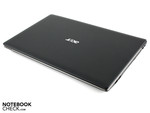
The Acer Aspire 7750G-2634G50Bnkk is equipped with new hardware and excels in two absolute contrary fields. For one thing, the performance with Sandy Bridge's quad core i7-2630M (2.0 GHz) is superior to the strongest mobile quad cores to date. For another, the power consumption in idle is considerably lower than in earlier 45 watt Arrandale quad cores of the same category. Consequently, the battery life is increased, also due to an awesome 99 watt hour battery, to five hours (WLAN test).
The AMD Radeon HD 6850M graphics card can run current games in high or even maximum details. However, the GPU lags behind the GTX 460M (GDDR5) in higher resolutions due to the slower GDDR3 video memory.
At a price of almost 1000 euros, the Aspire 7750G-2634G50Bnkk appears to be a fair deal. If you don't need many interfaces and graciously disregard the unusual keyboard, you'll get a strong system fit for the future as of April. In the meantime, the Sandy Bridge recall will cause a delivery stoppage of the 7750G. See Intel's defective Sandy Bridge Chipsets – Status Report for more information.




